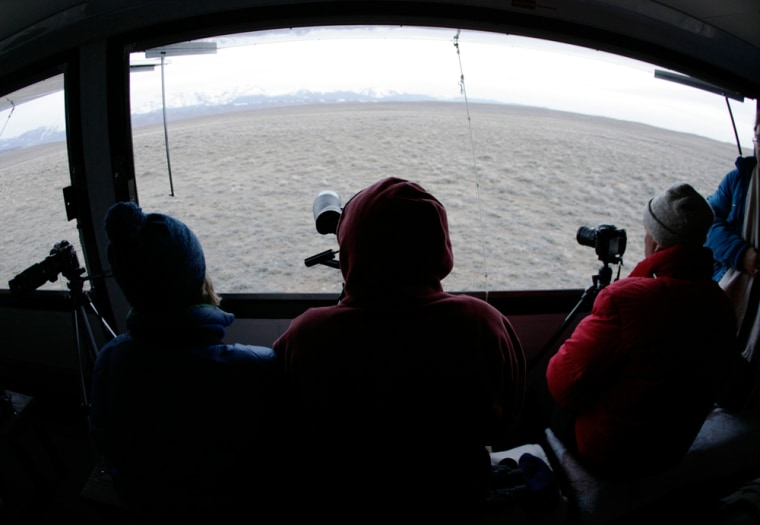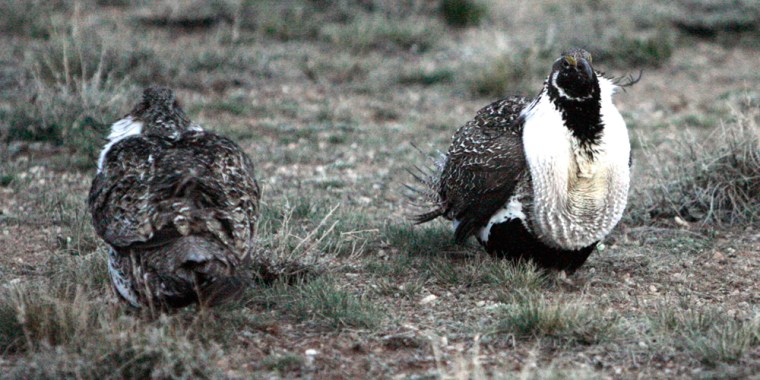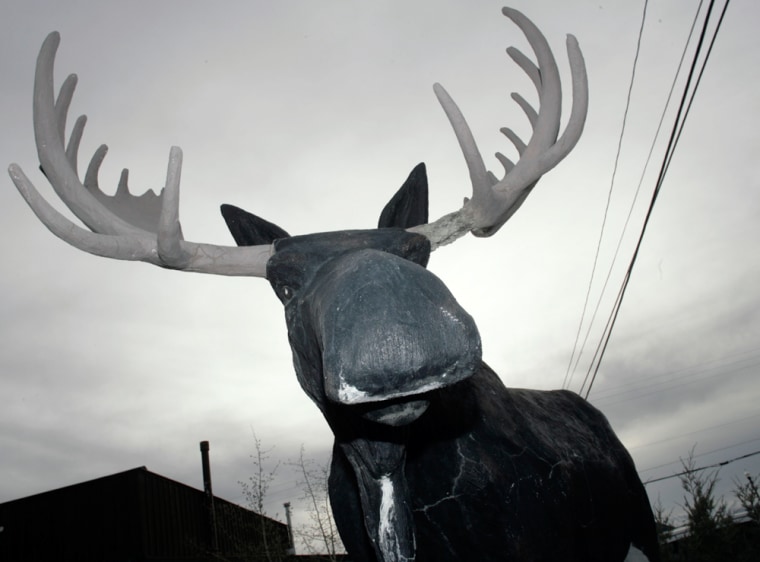People jostled cameras and squirmed on benches inside a trailer on a high-mountain meadow as the tour guide gently opened retractable doors, turning the bird blind into a window on one of nature's most spectacular shows: Strutting, chest-puffing male sage grouse in the last throes of mating season.
Dozens of greater sage grouse were first heard in the 5 a.m. darkness: Swishing sounds followed by pops, like a loud percolating coffee pot.
Light gradually spread over the meadow, brightening the jagged, snowcapped peaks of the Mount Zirkel Wilderness and revealing the source of the sounds - two big white air sacs on the birds' chests that repeatedly inflate and deflate. The brown and black birds, about 2 feet tall, fanned out their spiked tail feathers, trying to attract the two or three hens checking them out and charging at the other eager males.
The prancing stopped an hour later when a golden eagle looking for food swooped down and the grouse flew away in one bunch.
The abrupt end didn't disappoint visitors who drove 100 miles or more to get to Walden, a town of nearly 700 in north-central Colorado.
"That's quite a show. I was really impressed," said George Oetzel, a semiretired engineer from Boulder.
Oetzel has traveled to Australia and Costa Rica to see exotic wildlife, but he'd never seen the greater sage grouse, the largest of chicken-like birds on the Great Plains and rolling, sagebrush-dotted hills of the West. "I think there's a good chance we'll go again next year," he said.
Like numerous small towns whose traditional economic foundations are crumbling and populations are plummeting, Walden is struggling to survive. And like other towns in Colorado and the West, it's trying to capitalize on what's in its own backyard by offering sage grouse tours.

Monte Vista in south-central Colorado has a March celebration when thousands of sandhill cranes drop by the San Luis Valley on their northern migration. Wray, on the state's eastern plains, draws visitors from across the country in late March to watch prairie chickens go through their mating ritual.
Communities often team up with state and federal wildlife agencies and involve local residents and businesses to put on the festivals. In Wray, the town museum hosts a program and ranchers allow groups onto their land to see the prairie chickens' lek, or mating ground.
The Colorado Division of Wildlife has worked with other state agencies, landowners and wildlife groups to create a Web site about the Colorado Birding Trail, which grew out of development of a birding trail in southeast Colorado but has expanded with information on wildlife watching tips statewide.
Walden's chamber of commerce books sage grouse watchers in motels throughout town to spread the wealth. Chamber director Rea Redman estimates the grouse tours and birdwatchers out on their own provide up to 70 percent of the revenue in a "dead, slow month" for local restaurants and motels.
"Ice fishing is at an end. Snowmobiling is winding down. They don't really have anything going on too much before the summer tourist season comes along," Redman said.
The Moose Creek Cafe, where tour participants dined the night before rising at 3:30 a.m., would've been easy to find even without the life-size concrete moose out front. Several businesses on Walden's Main Street are vacant or closed until the tourist season gears up.
"This time of year we have almost no business, so this gives us some weekends where there are people coming in," said Bobbie Scott, owner of the Roundup Motel.
Scott's convinced that once people visit Walden, the largest community in remote North Park, they'll return.

North Park is a roughly 8,000-foot-high valley that's about 35 miles wide and 45 miles long. It's nearly encircled by mountains and encompasses the 24,800-acre Arapaho National Wildlife Refuge and the headwaters of the North Platte River.
Besides grouse, moose that roam the wetlands crisscrossing the valley floor have been a draw since the state restored them to the Walden area in the late 1970s. The town's welcome signs read: "Walden, moose viewing capital of Colorado."
A report by the U.S. Fish and Wildlife Service estimated that bird and wildlife watchers in 2001 spent $38.4 billion nationwide. Wildlife viewers in Colorado spent about $624 million 2001.
The agency is expected to release updated figures later this year.
"It is becoming more mainstream as a rural economic development tool as the Great Plains in particular have undergone significant social and economic change," said Ted Eubanks, whose Austin, Texas-based Fermata Inc. works with communities nationwide to promote their natural resources, wildlife or cultural history.
"What I've found is that most communities do have something, but most can't see it because they grew up with it," Eubanks said.
Even the absence of something can be an asset. Eubanks said the dark skies of north-central Pennsylvania have turned Cherry Springs State Park into a popular destination for city dwellers attending stargazing parties.
Eubanks sees backyard nature tourism as a growing trend. He started his business nearly two decades ago and now works in eight or nine states at a time, concentrating on events he considers environmentally sustainable.
It can be tough for small, financially strapped communities to find the resources and local leaders to follow through on plans.
Newspaper owners Kris and Gary Hazelton were among residents who started an elk festival in Estes Park, the eastern gateway to Rocky Mountain National Park. The town about 70 miles northwest of Denver gets big crowds in the fall during elk mating season when the normally quiet bull elk call on females with a rumbling, guttural sound that ends in a loud squeal.
"It was a great motivation because people were coming up anyway. We thought we'd let people know what elk are about," Kris Hazelton said.
An estimated 8,000 people attended last year's two-day Elk Fest in a downtown park. This year's Elk Fest is Sept. 29-30 and will feature nature talks, music and American Indian storytelling.
State and federal wildlife officers serve as guides on shuttle-bus tours to Rocky Mountain National Park in search of bulging elk. Estes Park police officers and other residents fan out through the mountains to scout for herds so the guides know where to go.
A wedding party - in gowns and tuxedos - went on one of the tours three years ago, Hazelton said.
Organizers of the Walden sage grouse tours work closely with the Colorado Division of Wildlife, which provides the bird blind. The lek is on state trust land that's usually closed to the public.
State wildlife officer Josh Dilley said the tours are a chance to educate people about sage grouse and efforts to preserve the bird's habitat.
The U.S. Fish and Wildlife Service rejected a petition in 2005 to list the grouse as endangered but acknowledged that its habitat is under pressure from urban growth and energy development.
"And it brings folks to Walden who may not otherwise visit here," Dilley said of the tours. "Once they see what North Park has to offer, they come back for other opportunities."
